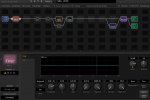InsideOut
Power User
I was thinking about having a tech put a high pass filter on my volume pot of my guitar, so when I roll volume down, I don't lose so much high end. Then I got thinking (and I would be surprised if I was the first to think of this) that I could use the Axe Fx to simulate this.
Using Filter block set to high shelf, and expression pedal, with toe down level at 0db and filter gain at 0db, it is basically just passing signal through like normal. But then with heal down, the block level reduces to -35db (set to taste for your guitar) and the high shelf @ 3k bumps up to +9 db (again set to taste).
So with this, I can clean up my high gain tones and not sound dull. Feel free to try it and discuss.
Heal down

Toe Down

Using Filter block set to high shelf, and expression pedal, with toe down level at 0db and filter gain at 0db, it is basically just passing signal through like normal. But then with heal down, the block level reduces to -35db (set to taste for your guitar) and the high shelf @ 3k bumps up to +9 db (again set to taste).
So with this, I can clean up my high gain tones and not sound dull. Feel free to try it and discuss.
Heal down

Toe Down

